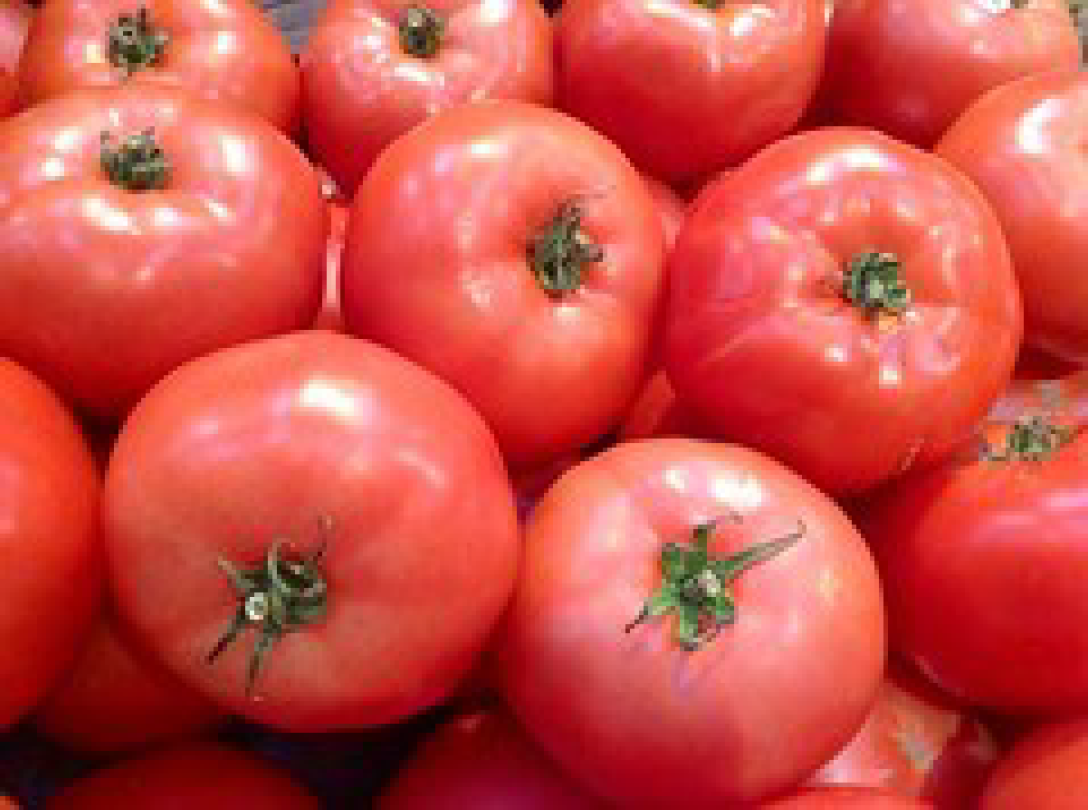3.3: Fruits-Vegetables
- Page ID
- 21213
\( \newcommand{\vecs}[1]{\overset { \scriptstyle \rightharpoonup} {\mathbf{#1}} } \)
\( \newcommand{\vecd}[1]{\overset{-\!-\!\rightharpoonup}{\vphantom{a}\smash {#1}}} \)
\( \newcommand{\id}{\mathrm{id}}\) \( \newcommand{\Span}{\mathrm{span}}\)
( \newcommand{\kernel}{\mathrm{null}\,}\) \( \newcommand{\range}{\mathrm{range}\,}\)
\( \newcommand{\RealPart}{\mathrm{Re}}\) \( \newcommand{\ImaginaryPart}{\mathrm{Im}}\)
\( \newcommand{\Argument}{\mathrm{Arg}}\) \( \newcommand{\norm}[1]{\| #1 \|}\)
\( \newcommand{\inner}[2]{\langle #1, #2 \rangle}\)
\( \newcommand{\Span}{\mathrm{span}}\)
\( \newcommand{\id}{\mathrm{id}}\)
\( \newcommand{\Span}{\mathrm{span}}\)
\( \newcommand{\kernel}{\mathrm{null}\,}\)
\( \newcommand{\range}{\mathrm{range}\,}\)
\( \newcommand{\RealPart}{\mathrm{Re}}\)
\( \newcommand{\ImaginaryPart}{\mathrm{Im}}\)
\( \newcommand{\Argument}{\mathrm{Arg}}\)
\( \newcommand{\norm}[1]{\| #1 \|}\)
\( \newcommand{\inner}[2]{\langle #1, #2 \rangle}\)
\( \newcommand{\Span}{\mathrm{span}}\) \( \newcommand{\AA}{\unicode[.8,0]{x212B}}\)
\( \newcommand{\vectorA}[1]{\vec{#1}} % arrow\)
\( \newcommand{\vectorAt}[1]{\vec{\text{#1}}} % arrow\)
\( \newcommand{\vectorB}[1]{\overset { \scriptstyle \rightharpoonup} {\mathbf{#1}} } \)
\( \newcommand{\vectorC}[1]{\textbf{#1}} \)
\( \newcommand{\vectorD}[1]{\overrightarrow{#1}} \)
\( \newcommand{\vectorDt}[1]{\overrightarrow{\text{#1}}} \)
\( \newcommand{\vectE}[1]{\overset{-\!-\!\rightharpoonup}{\vphantom{a}\smash{\mathbf {#1}}}} \)
\( \newcommand{\vecs}[1]{\overset { \scriptstyle \rightharpoonup} {\mathbf{#1}} } \)
\( \newcommand{\vecd}[1]{\overset{-\!-\!\rightharpoonup}{\vphantom{a}\smash {#1}}} \)
\(\newcommand{\avec}{\mathbf a}\) \(\newcommand{\bvec}{\mathbf b}\) \(\newcommand{\cvec}{\mathbf c}\) \(\newcommand{\dvec}{\mathbf d}\) \(\newcommand{\dtil}{\widetilde{\mathbf d}}\) \(\newcommand{\evec}{\mathbf e}\) \(\newcommand{\fvec}{\mathbf f}\) \(\newcommand{\nvec}{\mathbf n}\) \(\newcommand{\pvec}{\mathbf p}\) \(\newcommand{\qvec}{\mathbf q}\) \(\newcommand{\svec}{\mathbf s}\) \(\newcommand{\tvec}{\mathbf t}\) \(\newcommand{\uvec}{\mathbf u}\) \(\newcommand{\vvec}{\mathbf v}\) \(\newcommand{\wvec}{\mathbf w}\) \(\newcommand{\xvec}{\mathbf x}\) \(\newcommand{\yvec}{\mathbf y}\) \(\newcommand{\zvec}{\mathbf z}\) \(\newcommand{\rvec}{\mathbf r}\) \(\newcommand{\mvec}{\mathbf m}\) \(\newcommand{\zerovec}{\mathbf 0}\) \(\newcommand{\onevec}{\mathbf 1}\) \(\newcommand{\real}{\mathbb R}\) \(\newcommand{\twovec}[2]{\left[\begin{array}{r}#1 \\ #2 \end{array}\right]}\) \(\newcommand{\ctwovec}[2]{\left[\begin{array}{c}#1 \\ #2 \end{array}\right]}\) \(\newcommand{\threevec}[3]{\left[\begin{array}{r}#1 \\ #2 \\ #3 \end{array}\right]}\) \(\newcommand{\cthreevec}[3]{\left[\begin{array}{c}#1 \\ #2 \\ #3 \end{array}\right]}\) \(\newcommand{\fourvec}[4]{\left[\begin{array}{r}#1 \\ #2 \\ #3 \\ #4 \end{array}\right]}\) \(\newcommand{\cfourvec}[4]{\left[\begin{array}{c}#1 \\ #2 \\ #3 \\ #4 \end{array}\right]}\) \(\newcommand{\fivevec}[5]{\left[\begin{array}{r}#1 \\ #2 \\ #3 \\ #4 \\ #5 \\ \end{array}\right]}\) \(\newcommand{\cfivevec}[5]{\left[\begin{array}{c}#1 \\ #2 \\ #3 \\ #4 \\ #5 \\ \end{array}\right]}\) \(\newcommand{\mattwo}[4]{\left[\begin{array}{rr}#1 \amp #2 \\ #3 \amp #4 \\ \end{array}\right]}\) \(\newcommand{\laspan}[1]{\text{Span}\{#1\}}\) \(\newcommand{\bcal}{\cal B}\) \(\newcommand{\ccal}{\cal C}\) \(\newcommand{\scal}{\cal S}\) \(\newcommand{\wcal}{\cal W}\) \(\newcommand{\ecal}{\cal E}\) \(\newcommand{\coords}[2]{\left\{#1\right\}_{#2}}\) \(\newcommand{\gray}[1]{\color{gray}{#1}}\) \(\newcommand{\lgray}[1]{\color{lightgray}{#1}}\) \(\newcommand{\rank}{\operatorname{rank}}\) \(\newcommand{\row}{\text{Row}}\) \(\newcommand{\col}{\text{Col}}\) \(\renewcommand{\row}{\text{Row}}\) \(\newcommand{\nul}{\text{Nul}}\) \(\newcommand{\var}{\text{Var}}\) \(\newcommand{\corr}{\text{corr}}\) \(\newcommand{\len}[1]{\left|#1\right|}\) \(\newcommand{\bbar}{\overline{\bvec}}\) \(\newcommand{\bhat}{\widehat{\bvec}}\) \(\newcommand{\bperp}{\bvec^\perp}\) \(\newcommand{\xhat}{\widehat{\xvec}}\) \(\newcommand{\vhat}{\widehat{\vvec}}\) \(\newcommand{\uhat}{\widehat{\uvec}}\) \(\newcommand{\what}{\widehat{\wvec}}\) \(\newcommand{\Sighat}{\widehat{\Sigma}}\) \(\newcommand{\lt}{<}\) \(\newcommand{\gt}{>}\) \(\newcommand{\amp}{&}\) \(\definecolor{fillinmathshade}{gray}{0.9}\)Botanists classify avocados, eggplants, peppers and tomatoes as fruits because they develop from the ovary of flowering plants and contain one or more seeds. Chefs, however, prepare and serve them like vegetables; therefore, they are discussed here.
Avocados
Avocados include several varieties of pear-shaped fruits with rich, high-fat flesh. This light golden-green flesh surrounds a large, inedible, oval-shaped seed (pit). Some varieties have smooth, green skin; others have pebbly, almost black skin. Avocados should be used at their peak of ripeness, a condition that lasts only briefly. Firm avocados lack the desired flavor and creamy texture. Ripe avocados should be soft to the touch but not mushy. Ripe Haas avocados have almost black skins; the skins of the other varieties remain green when ripe. Firm avocados can be left at room temperature to ripen and then refrigerated for one or two days. Avocados are generally used raw to garnish salads, mashed or pureed for sauce s, sliced for sandwiches or diced for omelets. Avocado halves are popular containers for chilled meat, fish, and shellfish or poultry salads. Because avocado flesh turns brown very quickly once cut, dip avocado halves or slices in lemon juice and keep unused portions tightly covered with plastic wrap.
- Select avocados that are free of blemishes or moist spots. The flesh should be free of dark spots or streaks. Available all year, the peak season for Haas avocados is April through October; for Fuertes avocados, it is November through April.
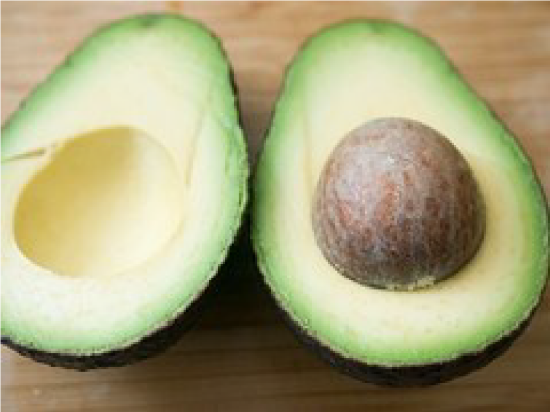
Eggplants
Two types of eggplants (Fr. Aubergine) are commonly available: Asian and western. Asian varieties are either round or long and thin, with skin colors ranging from creamy white to deep purple. Western eggplants, which are more common in the United States, tend to be shaped like a plump pear with a shiny lavender to purple-black skin. Both types have a dense, khaki-colored flesh with a rather bland flavor that absorbs other flavors well during cooking. Eggplants can be grilled, baked, steamed, fried or sautéed. They are commonly used in Mediterranean and Indian cuisines (especially in vegetarian dishes), but also appear in European and North American dishes. The skin may remain intact, or removed before or after cooking. Sliced eggplants may be salted and left to drain for 30 minutes to remove moisture and bitterness before cooking.
- Select plump, heavy eggplants with a smooth, shiny skin that is not blemished or wrinkled. Asian varieties tend to be softer than western. Eggplants are available all year; their peak season is during the late summer.
Eggplant - to salt or not salt?
Eggplants are filled with cells that contain water and are surrounded by tiny air pockets. The presence of heat will squeeze the air out of the pockets. If the eggplant has not been salted, oil is then free to seep into these pockets and the eggplant becomes soggy when fried. But when salt is sprinkled on an eggplant, it draws the water out of the cells. The cells then collapse, which in turn makes the air pockets collapse. As a result, no oil can seep into the tiny pockets during the frying process.
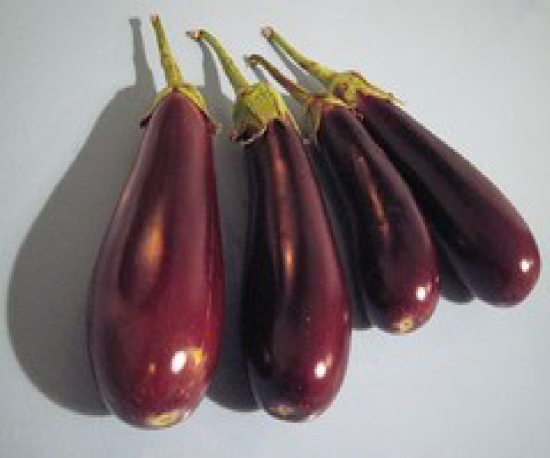
Peppers
Members of the Capsicum family are native to the New World. When "discovered" by Christopher Columbus, he called them "peppers" because of their sometimes-fiery flavor. These peppers, which include sweet peppers and hot peppers (chiles), are unrelated to peppercorns, the Asian spice for which Columbus was actually searching. Interestingly, New World peppers were readily accepted in Indian and Asian cuisines, in which they are now considered staples.
One can find fresh peppers in a wide range of colors - green, red, yellow, orange, purple and white - as well as shapes, from tiny teardrops to cones to spheres. They have dense flesh and a hollow central cavity. The flesh is lined with placental ribs (the white internal veins), to which tiny yellowish -white seeds are attach ed. A core of seeds is also attached to the stem end of each pepper.
Chile peppers get their heat from capsaicin, which is found not in the flesh or seeds, but in the placental ribs. Thus, a pepper's heat can be greatly reduced by carefully removing the ribs and attached seeds. Generally, the smaller the chile, the hotter it is. The amount of heat varies from variety to variety, how ever, and even from one pepper to another depending on growing conditions. Hot, dry conditions result in hotter peppers than do cool, moist conditions.
When selecting peppers, choose those that are plump and brilliantly colored with smooth, unblemished skins. Avoid wrinkled, pitted or blistered peppers. A bright green stem indicates freshness. The searing heat of a Scotch bonnet or habanero can burn. Wearing gloves is recommended when working with these chile peppers.
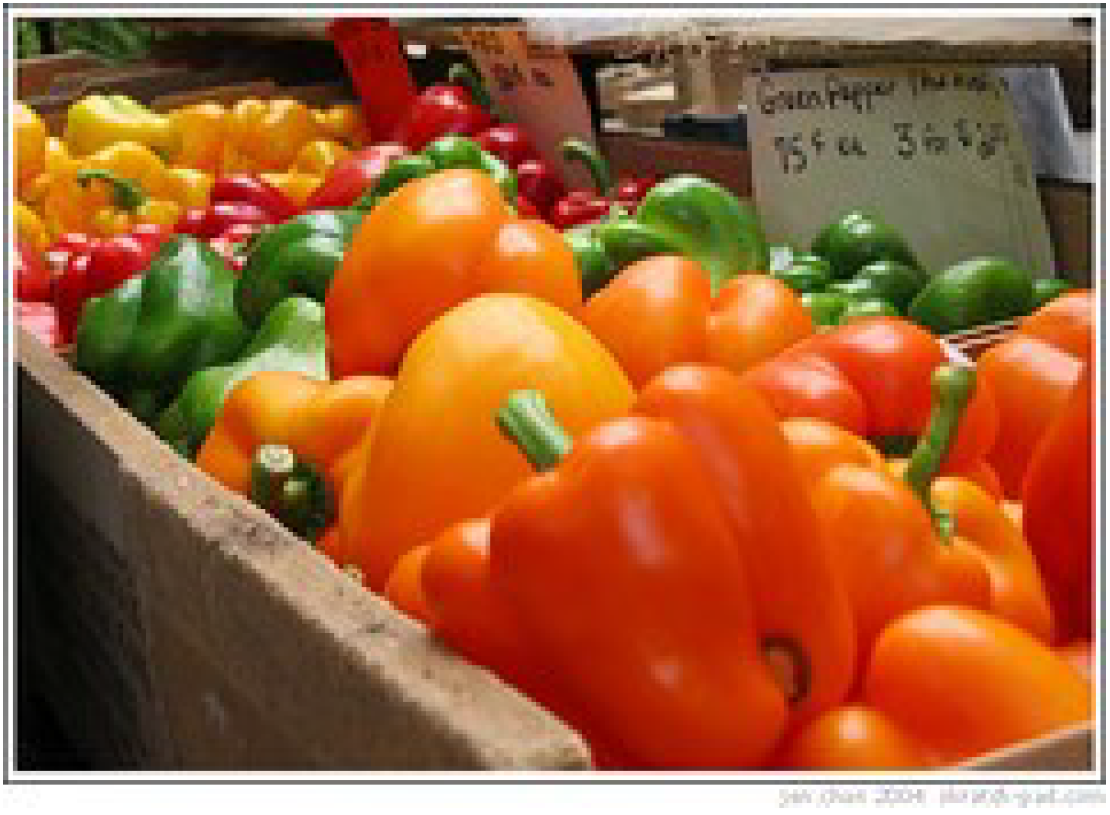
Sweet Peppers
Common sweet peppers, known as bell peppers, are thick -walled fruits available in green, red, yellow, purple, orange and other colors. They are heartshaped or boxy, with a short stem and crisp flesh. Their flavor is warm, sweet (red peppers tend to be the sweetest) and relatively mild. Raw bell peppers may be sliced or diced and used in salads or sandwiches. Bell peppers can also be stuffed and baked, grilled, fried, sautéed or pureed for soups, sauces or condiments. Green bell peppers are available all year; other colors are more readily available during the summer and fall.
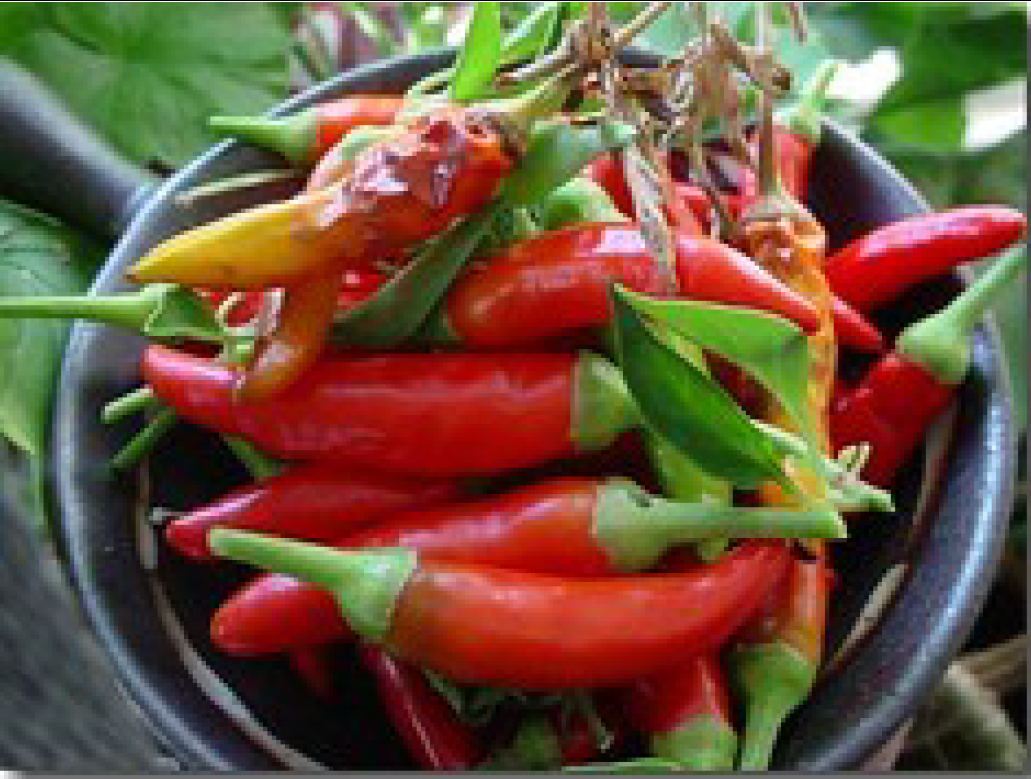
Hot Peppers
Hot peppers, also known as chiles, are also members of the Capsicum family. Although a chile's most characteristic attribute is its pungency, each chile actually has a distinctive flavor, from mild and rich to spicy and sweet to fiery hot. Chiles are commonly used in Asian, Indian, Mexican and Latin American cuisines. The larger (and milder) of the hot peppers, such as Anaheim and poblano, can be stuffed and baked or sautéed as a side dish. Most chiles, however, are used to add flavor and seasoning to sauces and other dishes. Fresh chiles are available all year and are also available canned in a variety of processed forms such as whole or diced, roasted, pickled or marinated.
Dried chiles are widely used in Mexican, Central America n and southwestern cuisines. They can be ground to create a powdered spice called chilli, or soaked in a liquid and then pureed for sauces or condiments. Drying radically alters the flavor of chiles, making them stronger and more pungent. Just as one type of fresh chile cannot be substituted for another without altering a dish's flavor, so too dried chiles cannot be substituted without flavor changes.
Choose dried chiles that are clean and unbroken, with some flexibility. Avoid any with white spots or a stale aroma. Drying changes not only the pepper's flavor, but also its name. Regional variations in chile names also add to the confusion. Several of the more frequently encountered chiles are listed here according to the names most commonly used for both their fresh and dried forms.
| Fresh (Fresco) | Dried (Seco) |
|---|---|
| Anaheim | Mild red or California |
| Ancho | Ancho or pastilla |
| Chilaca | Pastilla or negro |
| Jalapeno | Chipotle (smoked) |
| Mirasol | Guajillo |
| New Mexico green | New Mexicored |
| New Mexico red | Chile Colorado |
| Pimento | Paprika |
| Poblano | Mulato |
Tomatillos
Tomatillos, also known as Mexican or husk tomatoes, grow on small, weedy bushes. They are bright green, about the size of a small tomato, and are covered with a thin, papery husk. They have a tart, lemony flavor and crisp, moist flesh. Although they are an important ingredient in southwestern and northern Mexican cuisines, tomatillos may not be readily available in other areas. Tomatillos can be used raw in salads, pureed for salsa or cooked in soups, stews or vegetable dishes.
- Select tomatillos whose husks are split, but still look fresh. The skin should be plump, shiny and slightly sticky. They are available all year; their peak season is during the summer and fall.
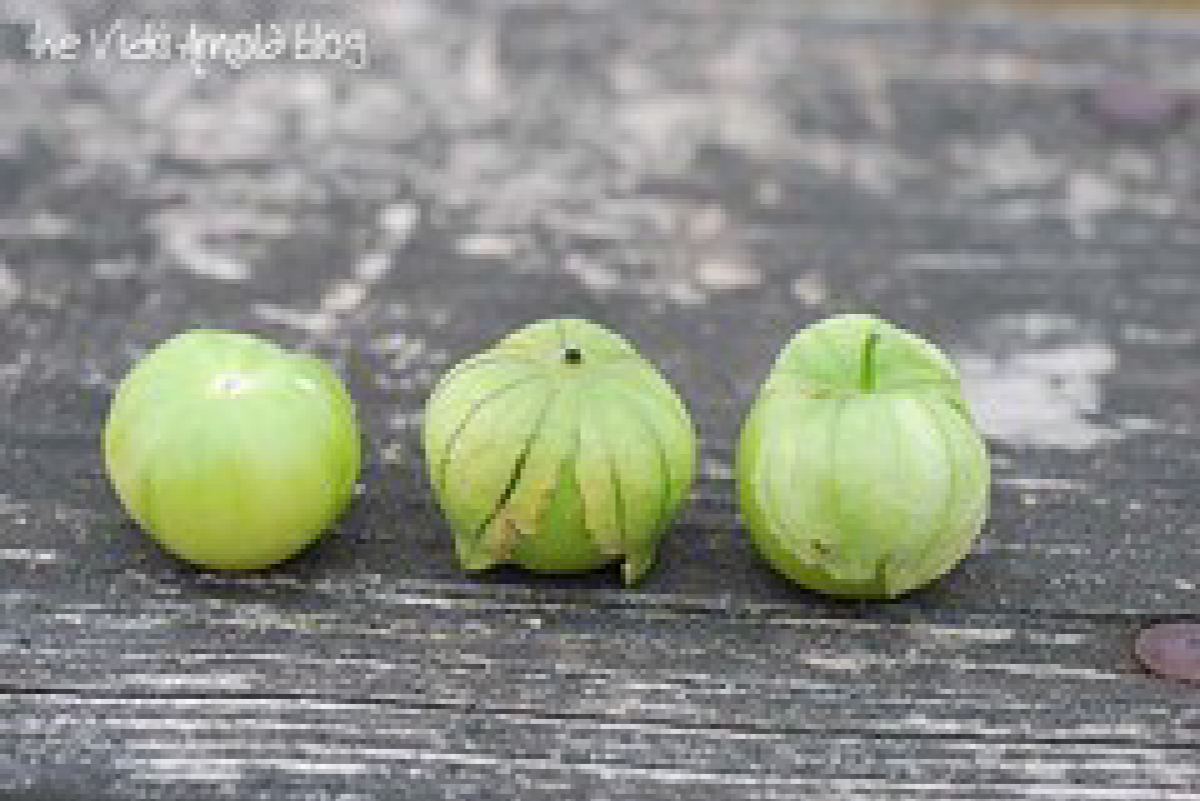
Tomatoes
Tomatoes (Fr. Tomate or pomme d'amour; It. pomodoro) are available in a wide variety of colors and shapes. They vary from green (unripe) to golden yellow to ruby red; from tiny spheres (currant tomatoes) to huge, squat ovals (beefsteak). Some, such as the plum tomato, have lots of meaty flesh with only a few seeds; others, such as the slicing tomato, have lots of seeds and juice, but only a few meaty membranes. All tomatoes have a similar flavor, but the levels of sweetness and acidity vary depending on the species, growing condition s and ripeness at harvest.
Because tomatoes are highly perishable, they are usually harvested when mature but still green (unripe), then shipped to wholesalers who ripen them in temperature- and humidity-controlled rooms. The effect on flavor and texture is unfortunate. Tomatoes are used widely in salads, soups, sauces and baked dishes. They are generally eaten raw, but can be grilled, pickled, pan-fried, roasted, or sautéed as a side dish.
- Select fresh tomatoes that are plump with a smooth, shiny skin. The color should be uniform and true for the variety. Tomatoes are available all year; most varieties have a summer peak season. Many canned tomato products are also available such as puree, paste, sauce, or stewed whole). Sun-dried and air-dried tomatoes are available in crumbs, pieces, slivers, or halves, dry or packed in oil. The dry-pack version can be soaked in oil or steeped in hot water to soften before use.
